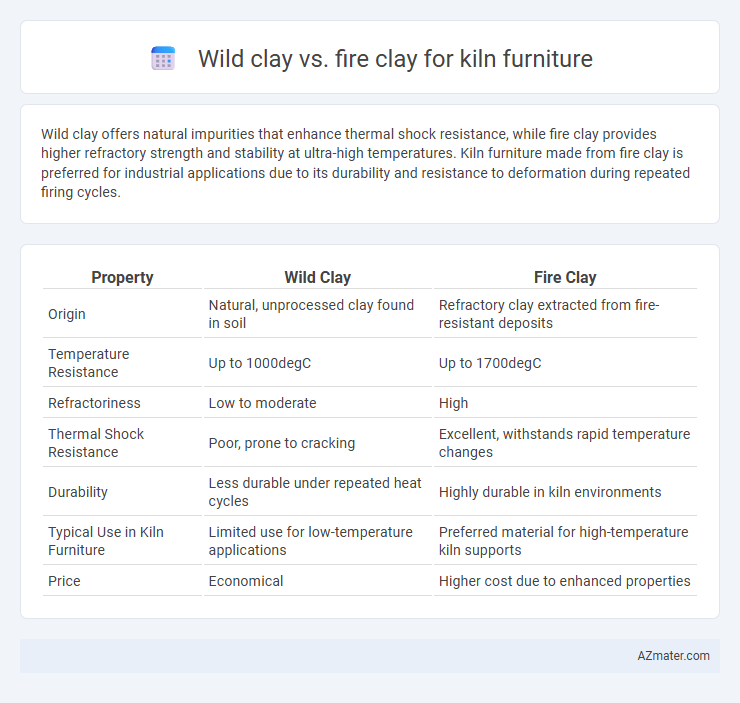Wild clay offers natural impurities that enhance thermal shock resistance, while fire clay provides higher refractory strength and stability at ultra-high temperatures. Kiln furniture made from fire clay is preferred for industrial applications due to its durability and resistance to deformation during repeated firing cycles.
Table of Comparison
| Property | Wild Clay | Fire Clay |
|---|---|---|
| Origin | Natural, unprocessed clay found in soil | Refractory clay extracted from fire-resistant deposits |
| Temperature Resistance | Up to 1000degC | Up to 1700degC |
| Refractoriness | Low to moderate | High |
| Thermal Shock Resistance | Poor, prone to cracking | Excellent, withstands rapid temperature changes |
| Durability | Less durable under repeated heat cycles | Highly durable in kiln environments |
| Typical Use in Kiln Furniture | Limited use for low-temperature applications | Preferred material for high-temperature kiln supports |
| Price | Economical | Higher cost due to enhanced properties |
Introduction to Kiln Furniture Materials
Wild clay and fire clay are fundamental materials used in kiln furniture due to their high refractory properties and thermal stability. Fire clay, rich in alumina and silica, withstands temperatures exceeding 1600degC, making it ideal for supporting ceramics during firing. Wild clay, often less processed, varies in composition but offers cost-effective durability, suitable for lower temperature firings and less demanding kiln applications.
What is Wild Clay?
Wild clay is a naturally occurring clay sourced directly from riverbanks or natural deposits, characterized by its organic impurities and unpredictable composition. It differs from fire clay, which is specifically refined for high-temperature resistance and uniformity, making fire clay more suitable for kiln furniture requiring durability under extreme heat. Wild clay's variable mineral content often limits its use in precise applications like kiln furniture, where consistent thermal stability is crucial.
Understanding Fire Clay
Fire clay, a refractory material composed primarily of alumina and silica, is essential for kiln furniture due to its high thermal stability and resistance to thermal shock. Unlike wild clay, fire clay contains a balanced mineral composition that enables it to withstand temperatures exceeding 1400degC without deformation or cracking, making it ideal for kiln shelves and supports. Its fine particle size and consistent quality ensure durability and efficiency in high-temperature firing processes.
Key Properties: Wild Clay vs Fire Clay
Wild clay exhibits lower thermal resistance and higher porosity compared to fire clay, making it less durable under extreme kiln temperatures. Fire clay contains higher alumina and silica content, providing superior thermal stability and resistance to thermal shock, which extends the lifespan of kiln furniture. Its dense structure and low impurity levels ensure consistent strength, essential for supporting heavy loads during high-temperature firing processes.
Sourcing and Sustainability
Wild clay, sourced directly from natural deposits, often exhibits variable mineral content and impurities, posing challenges for consistency in kiln furniture production but reducing industrial processing impacts. Fire clay, typically mined from managed quarries, offers uniformity and higher refractory properties, though its extraction may involve more significant environmental disturbance and carbon emissions. Sustainable practices prioritize wild clay harvesting with minimal land disruption or responsibly managed fire clay quarrying to balance performance needs with ecological preservation.
Performance Under High Temperatures
Wild clay generally exhibits lower thermal stability compared to fire clay, often leading to increased deformation and reduced lifespan in kiln furniture applications above 1200degC. Fire clay, known for its high alumina content (typically 25-40%), withstands prolonged exposure to temperatures exceeding 1400degC with minimal shrinkage and excellent structural integrity. The superior refractoriness of fire clay makes it the preferred choice for kiln furniture that must endure extreme thermal cycling without compromising mechanical strength.
Cost Comparison: Wild vs Fire Clay
Wild clay typically offers a lower initial cost compared to fire clay, making it a budget-friendly choice for kiln furniture in small-scale applications. Fire clay, known for its higher refractory properties and durability, commands a higher price due to its ability to withstand prolonged high temperatures and reduce replacement frequency. Evaluating the total cost of ownership involves considering fire clay's longevity and reduced maintenance against wild clay's affordability and quicker wear in intensive kiln environments.
Suitability for Kiln Furniture Applications
Fire clay is highly suitable for kiln furniture due to its high refractory properties, thermal stability, and resistance to deformation at elevated temperatures above 1400degC. Wild clay, often less processed and variable in composition, typically lacks the consistent high alumina content and durability required for repeated heating cycles in kiln furniture applications. Therefore, fire clay remains the preferred material for manufacturing durable, heat-resistant kiln shelves, setters, and supports used in ceramic and glass firing processes.
Challenges and Limitations
Wild clay presents variability in composition and plasticity, leading to inconsistent performance and increased risk of warping or cracking under high kiln temperatures. Fire clay offers superior refractory properties and higher resistance to thermal shock, but its higher cost and limited availability can restrict large-scale or budget-sensitive kiln furniture applications. Both materials require careful shaping and drying processes to minimize defects, with fire clay demanding precise firing regimes to fully develop its strength and durability.
Conclusion: Choosing the Right Clay for Kiln Furniture
Wild clay offers natural porosity and thermal shock resistance, making it suitable for kiln furniture that requires flexibility under fluctuating temperatures. Fire clay provides superior refractory strength and durability due to its high alumina content, ideal for prolonged exposure to high firing temperatures. Selecting the right clay depends on specific kiln operating conditions, with fire clay favored for intense, sustained heat and wild clay preferred for applications needing better thermal expansion adaptability.

Infographic: Wild clay vs Fire clay for Kiln furniture
 azmater.com
azmater.com